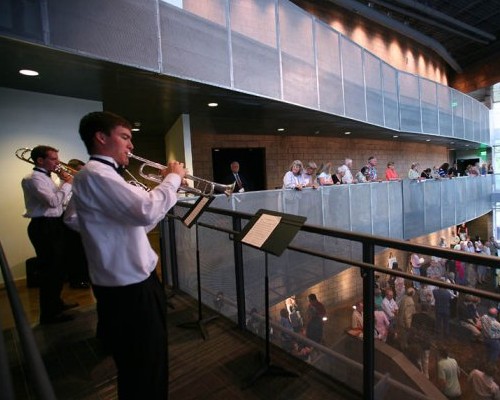On tonight's show:
Colorado College Summer Music Festival
Charley shamelessly promotes the benefit concert for the Festival on Friday with past performances in concert and the Performance Studio.
Camille Saint-Saëns: Violin Sonata No.1 in D minor, Op. 75
Scott Yoo, violin
Susan Grace, piano
recorded 6/29/08
Jon Manasse, clarinet
Jon Nakamatsu, piano
Charley Samson, page-turner
KVOD Performance Studio: recorded 5/29/07
Produced by Martin Skavish
Lowell Liebermann: Fantasy on a Fugue of J.S. Bach
Elizabeth Mann, flute
Frank Rosenwein, oboe
Jon Manasse, clarinet
Michael Kroth, bassoon
Stewart Rose, horn
Susan Grace, piano
KVOD Performance Studio: recorded 6/26/07
Produced by Martin Skavish
Robert Schumann (arr. Franz Liszt):
Jon Nakamatsu, piano
KVOD Performance Studio: recorded 4/24/09
Produced by Martin Skavish
Boulder Chamber Orchestra
Charley talks with Boulder Chamber Orchestra music director Bahman Saless about their concerts this weekend, followed by one of his soloist's appearance in our Performance Studio.
Jennifer Carsillo, violin
Charles Lee, cello
KVOD Performance Studio: recorded 9/24/09
Produced by Martin Skavish
Program Notes
Camille Saint-Saëns (1835-1921): Violin Sonata No. 1 in D minor, Op. 75
I. Allegro agitato--Adagio
II. Allegretto moderato--Allegro molto
“I live in music like a fish in water,” said Saint-Saëns. “I write music as an apple tree produces apples.” In an age when most French composers pursued opera, Saint-Saëns concentrated on instrumental music. Comparing himself to Georges Bizet, he remarked, “We pursue a different ideal, he seeking passion and life above all things, I running after the chimera of purity of style and perfection of form.” In 1871 Saint-Saëns founded the Société nationale de musique, whose purpose was to encourage French chamber music.
The first of his two violin sonatas was written in 1885 and dedicated to the Belgian violinist Martin-Pierre-Joseph Marsick. The two has just completed a recital tour of Switzerland and the sonata was probably a thank-you gift.
The work has two movements, each with two sections. In his liner notes to James Ehnes’s recording, Don Anderson writes, “The first half of the opening movement is restless and dramatic, lightened by a runny second theme. It segues into an Adagio of exceptional lyric sweetness. The second movement opens with a lightly dancing, scherzo-like section; a series of solemn piano chords heralds the steeple-chase virtuoso excitement of the finale.”
Johannes Brahms (1833-1897): Clarinet Sonata in F minor, Op. 120 No. 1
I. Allegro appassionato
II. Andante un poco adagio
III. Allegretto grazioso
IV. Vivace
Brahms was convinced he had written his last composition when he visited the Duke of Saxe-Meiningen's court in March, 1891. However, the playing of the principal clarinetist of the Duke's orchestra, Richard Mühlfeld, convinced him to resume composing again. “It is impossible to play the clarinet better than Herr Mühlfeld does here,” he wrote to Clara Schumann. Calling him “the best wind player I know,” Brahms wrote the Clarinet Trio and Clarinet Quintet with Mühlfeld in mind. During the summer of 1894 he added two clarinet sonatas for “my dear nightingale,” as he called him. They were his last chamber works.
Biographer Karl Geiringer writes: “Their manner is familiar: a wonderful exploitation of the possibilities of the clarinet, particularly in the effective change from the higher to the lower registers, coupled with a certain austerity of tone; a tender melancholy, which seldom breaks out into more energetic or joyous accents; and a splendid perfection of form in all the movements. And yet, amid these typical features, what a profusion of individual attributes! In the F minor Sonata, for instance, it is remarkable how in each of the three sections of the beautifully proportioned introductory movement the lyrical opening rises gradually to epic strength, leading to final victory in the softer mood of the Coda.”
©2010 Charley Samson
